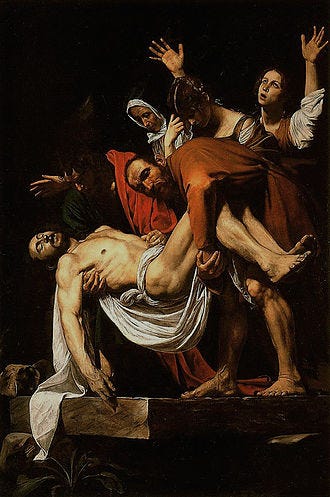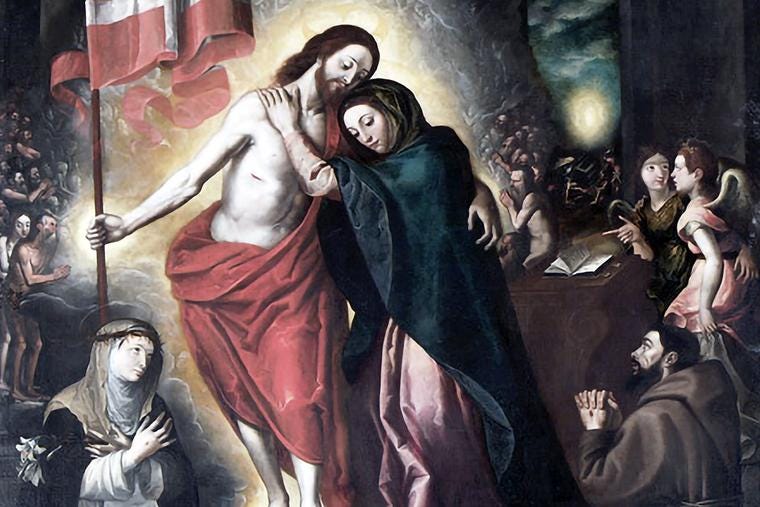The previous article can be found here.
The sorrows of The Blessed Mother culminate in this final act, the laying of her beloved Son in the tomb. This final sorrow can be seen as a type of journey in itself. After His cruel death, His lifeless body is laid in the arms of His mother as she weeps for love of Him. From that moment, she begins a new journey, one that begins at the foot of the cross and ends at the sepulcher. This journey, which is one that parents should never have to take, is one of immense grief. Finally, she comes to the place where her Son will be laid, and He is placed among the dead…
The Journey to the Tomb
“And they made His grave with the wicked and with the rich man in His death, although He had done no violence, and there was no deceit in His mouth.” Isaiah 53:9
Our Lady did not have all the time that she desired to cradle her Son in her arms after His crucifixion. The Gospels tell us that the Sabbath was quickly approaching, and they had to bury Him in a rushed manner.1 There should be no doubt in us that the time between the taking down from the cross and the departure to the tomb was some of the most agonizing that Our Lady ever experienced, and yet, she did not want them to end. But the sun was quickly setting, and the Sabbath was upon them. Joseph of Arimathea begs for the body of the Lord and donates his own tomb to lay the Lord in. This alone was an immense gift. Normally, the crucified would not get a proper burial, as they were seen as a curse upon the earth.2 During this time, the most likely scenario would have been that Our Lord would be left on the cross to decay, or His precious body would have been thrown into a mass grave. Joseph of Arimathea, in his love for the Lord, prevents this by begging Pilate for the body of the Lord.
Since the Sabbath was quickly approaching, the tomb was close to the place where Our Lord was crucified. By historical accounts, the tomb was only about 30 meters from the place of the crucifixion. While the distance was short, these are 30 of the most agonizing meters that Our Sorrowful Mother would have to walk. St. Alphonsus Ligouri gives a glimpse into this grief-filled journey:
“Thus was Mary, with her Son locked in her arms, absorbed in grief. The holy disciples, fearful that the poor Mother might die of grief, approached her to take the body of her Son from her arms, to bear it away for burial. This they did with gentle and respectful violence, and having embalmed it, they wrapped it in a linen cloth which was already prepared. On this cloth, which is still preserved at Turin, our Lord was pleased to leave to the world an impression of His sacred body. The disciples then bore Him to the tomb. To do this, they first of all raised the sacred body on their shoulders, and the mournful train set forth; choirs of angels from heaven accompanied it; the holy women followed, and with them the afflicted Mother also followed her Son to the place of burial.”3
Our Lord is processed from the mount of the crucifixion to the place of His burial in a manner befitting the King of Kings. Our Lady, full of grief, follows behind her gaze fixed on the body of her Son. The holy women support her for the journey, so short in the world’s measurements, but so long in the pierced heart of the Sorrowful Mother.
The Burial
“Now in the place where He was crucified there was a garden, and in the garden a new tomb where no one had ever been laid… they laid Jesus there.” John 19:41-42
When the procession arrives at the sepulcher, the disciples walk down into the tomb to rest the Holy Body on the stone slab, where it would remain until the party could return after the Sabbath to finish the burial ritual. St. Alphonsus recalls4 that many authors say that Our Lady accompanied the body of her Son into the sepulcher itself, descending into the depths of the grave with her Son. This seems fitting as Our Lady desired to be buried with her beloved Son. It is in these last moments that the Mother bids farewell to her Son, whom she will never see in the land of the living in the same way again. These last few precious moments are known only to the Mother and the Son.
Tradition holds that the disciples placed the crown of thorns and the nails of the crucifixion in the tomb as well. With that, the disciples rolled the stone in front of the tomb which is later sealed by the guard5 to prevent the body from being taken. Our Lady revealed to St. Bridget, “I can truly say that at the burial of my Son one tomb contained as it were two hearts.”6 Just as Our Lady was spiritually crucified with her Son, so too was she spiritually buried with her Son. Just as she had gone to the cross with her Son, so too did she go to the grave. While she could not stay, no doubt, her pierced heart remains in the tomb with her Son until the time of the resurrection.
St. Alphonsus beautifully reflects on this:
“Here I may be permitted to make a short digression, and remark that Mary’s heart was buried with Jesus, because Jesus was all her treasure… And where, may we ask, are our hearts buried? In creatures—perchance in mire. And why not in Jesus, who, although He has ascended to heaven, is still pleased to remain on earth, not dead indeed, but living in the most holy sacrament of the altar, precisely that our hearts may be with Him, and that He may possess them?”7
These beautiful words present us with a great mystery that when we spend time with Our Lord in the Eucharist, we may somehow give consolation to Our Lady at this time. Just as we give Our Lord consolation in His agony in the garden when we wait with Him for an hour.8
Upon closing the stone, St. Bonaventure records Our Lady blessing the stone, saying:
“O happy stone, that doth now enclose that sacred body, which for nine months was contained in my womb; I bless thee and envy thee; I leave thee the guardian of my Son, of that Son who is all my treasure and all my love.”9
The Sorrowful Mother then journeys home, walking past the cross of her Son, still wet with the sacred blood of the Lamb. Again, St. Bonaventure records her words:
“O holy cross, I kiss thee, I adore thee; for thou art no longer an infamous gibbet, but a throne of love and an altar of mercy, consecrated by the blood of the Divine Lamb, which on thee has been sacrificed the salvation of the world.”10
Perfect Hope in Grief
“Now on the first day of the week, Mary Magdalene came to the tomb early, while it was still dark, and saw that the stone had been taken away from the tomb.” John 20:1
The following two nights were stricken with immense grief for Our Blessed Mother. Just as they had been 20 years prior, when her Son was lost to her in the City of Jerusalem, Our Lady suffered immensely from the absence of her Son. This time, though, there was a perceived permanence. The certainty of death far exceeds the uncertainty of a child who is lost. And so, prepared by those three days of darkness when He was 12 years old, she descends into the darkness of death in union with her Son.
But in her grief, the ever-present perfection of Hope resides. In her weeping for her Son, she knew that the cross and the grave were not the end. All around her, the perceived permanence of death had taken hold of the disciples. Even John had no idea what was to come. But, sustained by grace and the promises of her Son,11 the Sorrowful Mother looked forward to the sunrise on Sunday.
Our Lady, full of confidence in the Goodness of God, knew that the grave would not consume her Son, and yet, she willingly underwent the suffering of grief to be united to her Son. It is here that she is close to those parents who have lost children. It is here that she is close to all those who mourn the loss of a loved one. And it is also here that she teaches us hope in the resurrection of Christ, that those who are united to Christ in a death like His will also be united to Him in the resurrection.
For Mary, a life of sorrows culminates in three days of grief. But after these three days, the glory of the resurrection shines through. Early on Sunday morning, before His appearance to anyone else, what more fitting act would there have been than to appear to His mother? Who else had merited such a consolation than the one who walked with Him from the moment of the Incarnation to the climax of the redemptive act? Of all people, the Mother of Sorrows would have been the one to see Him first. Just as she is the first to taste the fruits of the resurrection in her own resurrection before the Assumption, so too does she receive the consolation of the resurrected Christ on that glorious Sunday Morning.
Let us pray,
O most sorrowful Mary, I compassionate thee, for the anguish felt by thy loving heart when Jesus’ body was laid in the sepulcher. Dear Mother, by all the bitterness of desolation thou didst then know, obtain for me the virtue of diligence and the gift of wisdom.
Hail Mary…
Grant, we beseech Thee, O Lord Jesus Christ, that the most Blessed Virgin Mary, Thy Mother, may intercede for us before the throne of Thy mercy, now, and at the hour of our death; through whose most holy soul in the hour of Thine own Passion the sword of sorrow passed. Through Thee, Jesus Christ, Saviour of the world, Who lives and reigns with the Father and the Holy Spirit forever and ever.12
For more from Dr. McGovern, visit his Substack at A Thomist, Dedicated to the Theological tradition of St. Thomas Aquinas. Exploring Thomas' Spiritual Theology and topics in Christology and Mariology.
Cf. John 19:42.
Cf. Deuteronomy 21:22-23.
St. Alphonsus Ligouri, The Glories of Mary, 446. The artifact that St. Alphonsus mentions here is the Shroud of Turin, which is still preserved for veneration by the faithful. On it, we see the imprint of the crucified body of Jesus Christ, which modern science cannot reproduce.
Ibid. 447.
Cf. Matthew 27:66.
Revelations lib. ii. Cap. 21.
Glories of Mary, 447.
Cf. Matthew 26:40.
Glories of Mary, 448.
Ibid.
Cf. Matthew 20:17-19. There are three specific times when Christ predicts His death. This third time, recorded by St. Matthew, adds detail as well as the promise of the Resurrection. The Apostles, still darkened by disbelief and not having the fullness of the Holy Spirit, were still confused by this. On the other hand, it seems fitting that Mary, the Spouse of the Holy Spirit, infused with His gifts and grace, would have understood this prediction and looked forward both with trepidation to the passion and great hope to the resurrection.
Blessed Be God, Preserving Christian Publications: Boonville, NY, 2022.




